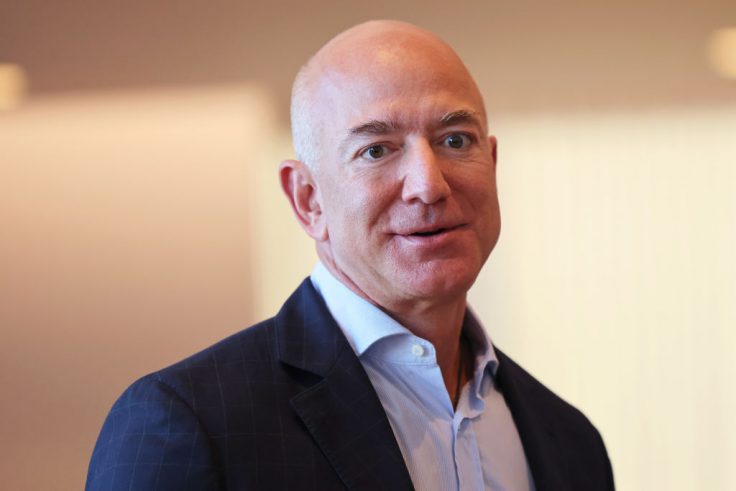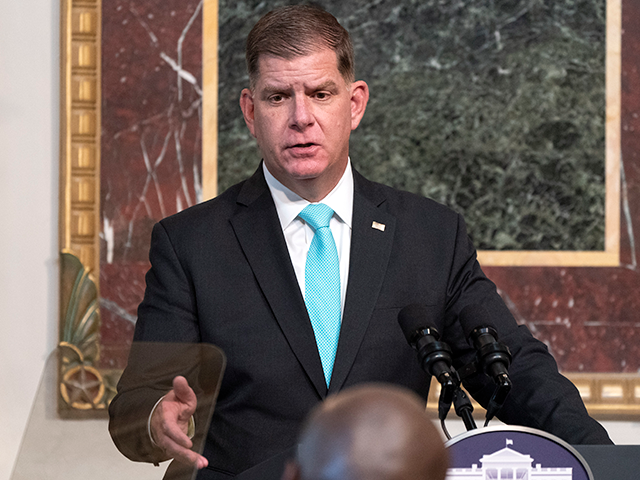JEFF BEZOS IS ONE OF JOE BIDEN'S BILLIONAIRES FOR OPEN BORDERS TO KEEP WAGES DEPRESSED!
HELL NO TO PAYING LIVING WAGES TO AMERICANS (LEGALS)!!!
The Democrat party’s pick for Secretary of Labor says CEOs are being victimized by a shortage of immigrant workers.
Amazon Faces Suit Over $10k Offer Made Exclusively to ‘Black, Latinx, and Native American Entrepreneurs’

A white woman is suing e-commerce giant Amazon over a program that gives "Black, Latinx, and Native American entrepreneurs" a $10,000 stipend to launch their own delivery startups, an offer the lawsuit calls "patently unlawful racial discrimination."
The online retailer delivers packages by contracting with local "delivery service partners"—outside businesses that drive parcels from point A to point B. To "help reduce the barriers to entry for Black, Latinx, and Native American entrepreneurs," Amazon’s website states, the company has created a "diversity grant" that offers minorities $10,000 to launch their own businesses and become delivery service partners.
"This means that businesses owned by blacks, Latinos, or Native Americans receive a $10,000 stipend from Amazon to become delivery service partners, while whites and Asian Americans who wish to become delivery service partners receive no such stipend and must foot the entire bill for their startup costs," the lawsuit says.
The plaintiff, Crystal Bolduc, is asking a Texas district court to end the program and award damages to everyone "who has suffered unlawful racial discrimination on account of" it. Filed on July 20 by some of the most prominent appellate lawyers in the country, the class-action lawsuit argues that the stipends violate the Civil Rights Act of 1866, which prohibits racial discrimination in contracting. Bolduc, the lawsuit says, "seeks to represent a class of all past and future applicants" to the program "who have been subjected to racial discrimination."
Amazon also runs a "Black Business Accelerator" that gives black-owned businesses a "$500 credit to assist with start-up and operational costs." That initiative, while not the subject of the class action, is nonetheless another case of "unlawful racial discrimination" at the online retailer, Bolduc’s lawsuit says.
The programs are just two examples of the race-conscious policies that have proliferated in corporations and nonprofits across the United States, often in violation of federal law. Google sets strict caps on the number of white and Asian students universities can nominate for a prestigious graduate fellowship; Pfizer’s "Breakthrough Fellowship" does not allow white or Asian applicants at all. At Women Against Abuse, one of the largest domestic violence nonprofits in the United States, "BIPOC" employees received a larger stipend than white ones to sit on a "racial equity audit task force"—a policy that is now the subject of a pending discrimination complaint.
Companies are not attempting to hide these seemingly discriminatory programs. Google and Pfizer both advertise their fellowships on company websites, even as civil rights lawyers say that they violate federal law.
Amazon is similarly brazen. The lawsuit includes several screenshots from the retail giant’s website, which promotes the race-based stipend scheme under the heading, "Commitment to Diversity." On another web page titled "Our partners," the company touts its Black Business Accelerator and says the program has the support of the U.S. Department of Commerce.
Amazon did not respond to a request for comment.
This is the second time in a year that Amazon has been hit with a reverse discrimination complaint. Last October, Jonathan Correll filed a class action lawsuit against the online retailer alleging that it discriminates against white sellers by giving preferential advertising to minority businesses. Amazon has asked a California district court to dismiss the lawsuit, in part on the grounds that Correll has never sold anything on Amazon and thus lacks the standing to challenge its advertising policies.
Bolduc may have a stronger case. Since she "cannot apply to become an Amazon delivery service partner without subjecting herself to racial discrimination," her lawsuit argues, Bolduc is "suffering injury" on account of the stipend program and therefore has the standing to challenge it.
Bolduc’s lawyers are a who’s who of the conservative legal movement. Her lawsuit was filed by Gene Hamilton, the general counsel of America First Legal who oversaw the end of DACA during the Trump administration; Jonathan Mitchell, the architect of the Texas "heartbeat" law that effectively circumvented Roe v. Wade; and Adam Mortara, the lead trial lawyer for the plaintiffs in Students for Fair Admissions v. Harvard, a pending Supreme Court case that could outlaw affirmative action.
"Ms. Bolduc will not apply to become an Amazon delivery service partner until Amazon eliminates this racially discriminatory policy," the lawsuit says, "either by extending its $10,000 benefit to whites and Asians or curtailing or eliminating the benefit entirely."
Biden’s Labor Chief Promotes Worker Replacement, Says Immigrants Are ‘Only Way’ to Fill Jobs

The Democrat party’s pick for Secretary of Labor says CEOs are being victimized by a shortage of immigrant workers.
Companies want to hire another 11 million people, Labor Secretary Marty Walsh told Fox News on September 2, adding:
If those 11 million jobs had to be filled tomorrow, we certainly don’t have enough people in the United States to fill those jobs … the issue of workers has to be addressed and the only way [emphasis added] you can do it is through immigration.
“When I talk to CEOs from companies all across America, they’re all in favor of immigration reform,” he said, “they’re all in favor of pathways — of visas — for people coming into the United States working and we’re going to have to have that real serious conversation because at some point it will begin to impact our economy.”
But Walsh “doesn’t seem to know what’s going on in the U.S. labor market in terms of real wages for the less-educated, or the labor force participation,” responded Steve Camarota, research director at the Center for Immigration Studies.
“There are two main things that you could do [to get Americans into those jobs] — make it more attractive to work and make it less attractive to sit on your ass,” he said:
Could you ever get teenagers to work like they did in the 70s? No, but could you get a million more teenagers to work? Yeah. Could you ever get men to have the labor force participation rate of 96 percent — say non-college men 25 to 54 — that we had in 1964? No, but could you get it up to 88 percent instead of 84 percent or 83 percent? Yes.
The government should try to fill jobs with some of the roughly 60 million adults not working by allowing wages to rise, he said.
The Democrat party’s pick for Secretary of Labor says CEOs are being victimized by a shortage of immigrant workers.
The Democrat party’s pick for Secretary of Labor says CEOs are being victimized by a shortage of immigrant workers.
Amazon Closes, Abandons Plans for Dozens of US Warehouses
(Bloomberg) -- Amazon.com Inc., determined to reduce the size of its sprawling delivery operation amid slowing sales growth, has abandoned dozens of existing and planned facilities around the US, according to a closely watched consulting firm.
Most Read from Bloomberg
Europe’s Energy Crisis Deepens After Russia Keeps Pipeline Shut
UK Slips Behind India to Become World’s Sixth Biggest Economy
Elizabeth Holmes Judge Upholds Conviction in Preliminary Ruling
MWPVL International Inc., which tracks Amazon’s real-estate footprint, estimates the company has either shuttered or killed plans to open 42 facilities totaling almost 25 million square feet of usable space. The company has delayed opening an additional 21 locations, totaling nearly 28 million square feet, according to MWPVL. The e-commerce giant also has canceled a handful of European projects, mostly in Spain, the firm said.
Just this week Amazon warned officials in Maryland that it plans to close two delivery stations next month in Hanover and Essex, near Baltimore, that employ more than 300 people. The moves are a striking contrast with previous years, when the world’s largest e-commerce company typically entered the fall rushing to open new facilities and hire thousands of workers to prepare for the holiday shopping season. Amazon continues to open facilities where it requires more space to meet customer demand.
“There remains some serious cutting to do before year-end -- in North America and the rest of the world,” said Marc Wulfraat, MWPVL’s founder and president. “Having said this, they continue to go live with new facilities this year at an astonishing pace.”
Maria Boschetti, an Amazon spokesperson, said it’s common for the company to explore multiple locations at once and make adjustments “based upon needs across the network.”
“We weigh a variety of factors when deciding where to develop future sites to best serve customers,” she said in an emailed statement. “We have dozens of fulfillment centers, sortation centers and delivery stations under construction and evolving around the world.”
The Maryland closings are part of an initiative to shift work to more modern buildings, Amazon says. “We regularly look at how we can improve the experience for our employees, partners, drivers and customers, and that includes upgrading our facilities,” Boschetti said. “As part of that effort, we’ll be closing our delivery stations in Hanover and Essex and offering all employees the opportunity to transfer to several different delivery stations close by.”
Chief Executive Officer Andy Jassy has pledged to unwind part of a pandemic-era expansion that saddled Amazon with a surfeit of warehouse space and too many employees. The company has typically weaned its ranks of hourly workers by leaving vacant positions open, slowing hiring and tightening disciplinary or productivity standards. But warehouse closings are also part of the mix, and workers are bracing for more. During the second quarter, Amazon’s workforce shrank by roughly 100,000 jobs to 1.52 million, the biggest quarter-to-quarter contraction in the company’s history.
The Seattle company has also been seeking to sub-lease at least 10 million square feet of warehouse space, Bloomberg reported in May.
When homebound shoppers stampeded online during the pandemic, Amazon responded by doubling the size of its logistics network over a two-year period, a rapid buildout that exceeded that of rivals and partners like Walmart Inc., United Parcel Service Inc. and FedEx Corp. For a time, Amazon was opening a new warehouse somewhere in the U.S. roughly every 24 hours. Jassy told Bloomberg in June that the company had decided in early 2021 to build toward the high end of its forecasts for shopper demand, erring on the side of having too much warehouse space rather than too little.
Wulfraat said that most of the closings announced this year are delivery stations, smaller buildings that hand off already packaged items to drivers. Facilities that have been canceled include several planned fulfillment centers, giant warehouses containing millions of items. MWPVL estimates that Amazon operates more than 1,200 logistics facilities, large and small, around the US.
More belt-tightening could complicate Amazon’s already fraught relations with organized labor. Earlier this year, an upstart labor union started by a fired Amazon worker won a historic victory at a company warehouse in Staten Island, New York. A federal labor official on Thursday rejected Amazon’s bid to overturn the result. Last month, workers at an Amazon facility near Albany, New York, filed a petition to hold a union election there.
How much overcapacity Amazon needs to work through is hard to gauge, and some analysts believe the extra space will come in handy during the Christmas holiday season.
(Updated with additional Amazon comment beginning in the fifth paragraph.)
Most Read from Bloomberg Businessweek

No comments:
Post a Comment